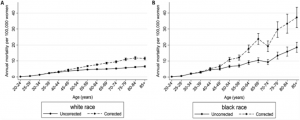Study Reveals Significantly Higher Cervical Cancer Mortality Rates among Black Women Compared to White Women
By Harris Onywera
Cervical cancer is the first and second most common cancer type among reproductive-age women in South Africa and world, correspondingly. The incidence rate per 100,000 population is higher in less developed regions (15.7%) than in more developed regions (9.9%). Globally, it is estimated that 527,624 cervical cancer cases reported annually, concomitantly with about 50.4% new cervical cancer deaths.
There is documented evidence for racial disparity in cervical cancer mortality rates. A recent survey estimating the cervical cancer mortality rates in the US from the Surveillance, Epidemiology, and End Results and National Centre for Health Statistics county mortality data (2000-2012) found that after correcting for hysterectomy, Black and White women had 76% and 48% higher cervical cancer mortality rates, respectively, than previously estimated. The prevalence of hysterectomy (surgical removal of the uterus) was higher in Black women than in White women. Prior to excluding women with hysterectomies, (uncorrected) cervical cancer mortality rate was 5.7 and 3.2 per 100,000 in Black and White women, respectively (Figure 1). In the same order, the corrected rates were 10.1 and 4.7 per 100,000. It was also observed that age-specific cervical cancer mortality rates were higher among women aged 65+ years, with up to 126% increase among Black aged 65-69 years. The percentage increase for White women of the same age was 75%. For White women, cervical cancer mortality rate was highest (96%) among women aged 75-79 years. Black women of similar age still exhibited a high increase of 122%.
In my opinion, I think it would be of great public health relevance to perform a similar kind of analysis in sub-Saharan region where cervical cancer mortality rates are underreported, yet very high.
For more information, visit the sources provide below.

Source link: Bruni et al. (2017) and Beavis et al. (2017).

It’s a nice study in cancer genetics especially in a multi racial countries. However, the experience would not be the same in other countries in Sub Saharan Africa because there is very low population of Whites to reach a conclusive sample size.
I agree, but I am suggesting that the analysis be done on the Blacks Africa women. Generally, Africans (Blacks) are known to be the most ethnically and diverse populations in the world. At the same time, women in sub-Saharan may not have frequent access to healthcare. Thus, one might find that hysterectomy-corrected cervical cancer mortality rate is higher than the uncorrected rate (which is usually reported).